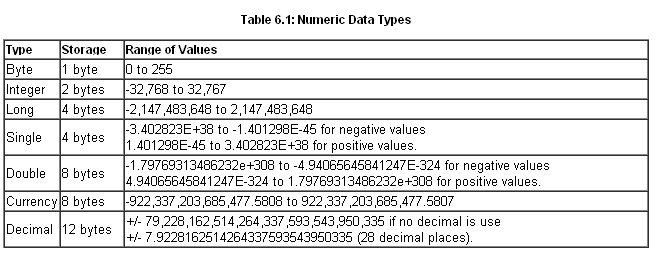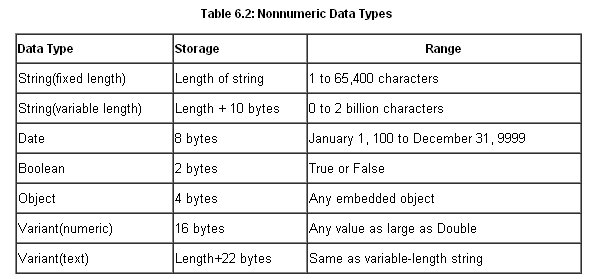[Lesson 5]<< [CONTENTS] >> [Lesson 7]
Everyday we deal with many kinds of data. Examples of data are names, addresses, money, dates, share prices, bills, phone numbers and more. Similarly in Visual Basic 2010, we have to deal different types of data.
6.1 Visual Basic 2010 Data Types
Visual Basic 2010 classifies data into two major data types, the numeric data types and the non-numeric data types.
6.1.1 Numeric Data Types
6.1.2 Non-numeric Data Types
Nonnumeric data types are data that cannot be manipulated mathematically using standard arithmetic operators. The non-numeric data comprises text or string data types, the Date data types, the Boolean data types that store only two values (true or false), Object data type and Variant data type .They are summarized in Table 6.2
6.1.3 Suffixes for Literals
In addition, we need to enclose string literals within two quotations and date and time literals within two # sign. Strings can contain any characters, including numbers. The following are few examples:
memberName=”Taal, Modou.”
TelNumber=”1800-900-888-777″
LastDay=#31-Dec-00#
ExpTime=#12:00 am#
6.2 Managing Variables
Variables are like mail boxes in the post office. The contents of the variables changes every now and then, just like the mail boxes. In term of VB2010, variables are areas allocated by the computer memory to hold data. Like the mail boxes, each variable must be given a name. To name a variable in Visual Basic 2010, you have to follow a set of rules.
6.2.1 Variable Names
The following are the rules when naming the variables in Visual Basic 2010
It must be less than 255 characters
No spacing is allowed
It must not begin with a number
Period is not permitted
Examples of valid and invalid variable names are displayed in Table 6.4

6.2.2 Declaring Variables
In Visual Basic 2010, one needs to declare the variables before using them by assigning names and data types. If you fail to do so, the program will show an error. They are normally declared in the general section of the codes’ windows using the Dim statement.
The format is as follows:
Dim Variable Name As Data Type
Example 6.1
Private Sub Form1_Load(ByVal sender As System.Object, ByVal e As System.EventArgs) Handles MyBase.Load
Dim password As String
Dim yourName As String
Dim firstnum As Integer
Dim secondnum As Integer
Dim total As Integer
Dim doDate As Date
End Sub
You may also combine them in one line , separating each variable with a comma, as follows:
Dim password As String, yourName As String, firstnum As Integer,………….
For string declaration, there are two possible formats, one for the variable-length string and another for the fixed-length string. For the variable-length string, just use the same format as example 6.1 above. However, for the fixed-length string, you have to use the format as shown below:
Dim VariableName as String * n, where n defines the number of characters the string can hold.
Example 6.2:
Dim yourName as String * 10
yourName can holds no more than 10 Characters.
6.2.3 Assigning Values to Variables
After declaring various variables using the Dim statements, we can assign values to those variables. The general format of an assignment is
Variable=Expression
The variable can be a declared variable or a control property value. The expression could be a mathematical expression, a number, a string, a Boolean value (true or false) and etc. The following are some examples:
firstNumber=100
secondNumber=firstNumber-99
userName=”Baboucarr Njie”
userpass.Text = password
Label1.Visible = True
Command1.Visible = false
Label4.Caption = textbox1.Text
ThirdNumber = Val(usernum1.Text)
total = firstNumber + secondNumber+ThirdNumber
6.3 Constants
Constants are different from variables in the sense that their values do not change during the running of the program.
6.3.1 Declaring a Constant
The format to declare a constant is
Const Constant Name As Data Type = Value
Example 6.3
Private Sub Form1_Load(ByVal sender As System.Object, ByVal e As System.EventArgs) Handles MyBase.Load
Const Pi As Single=3.142
Const Temp As Single=37
Const Score As Single=100
End Sub



